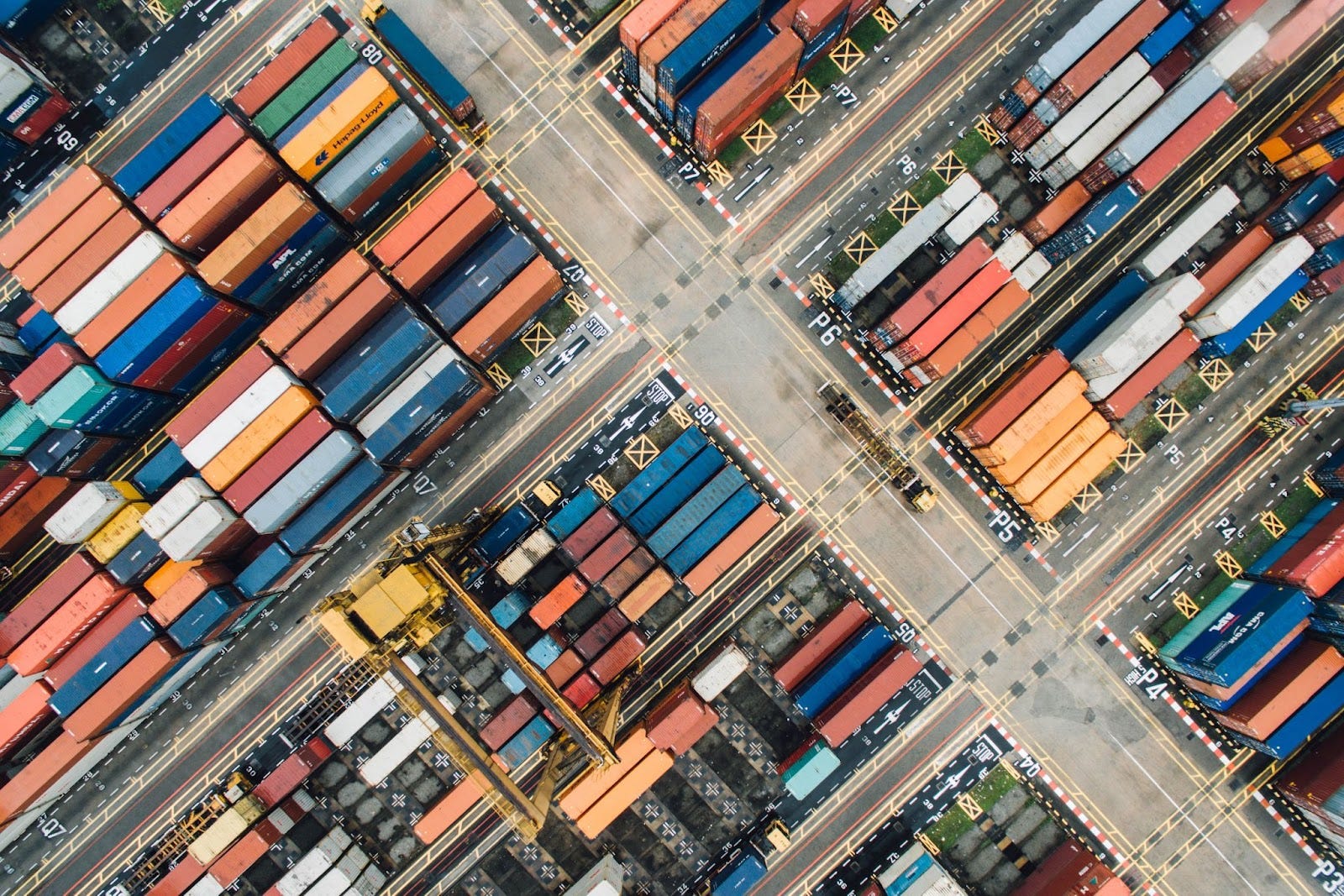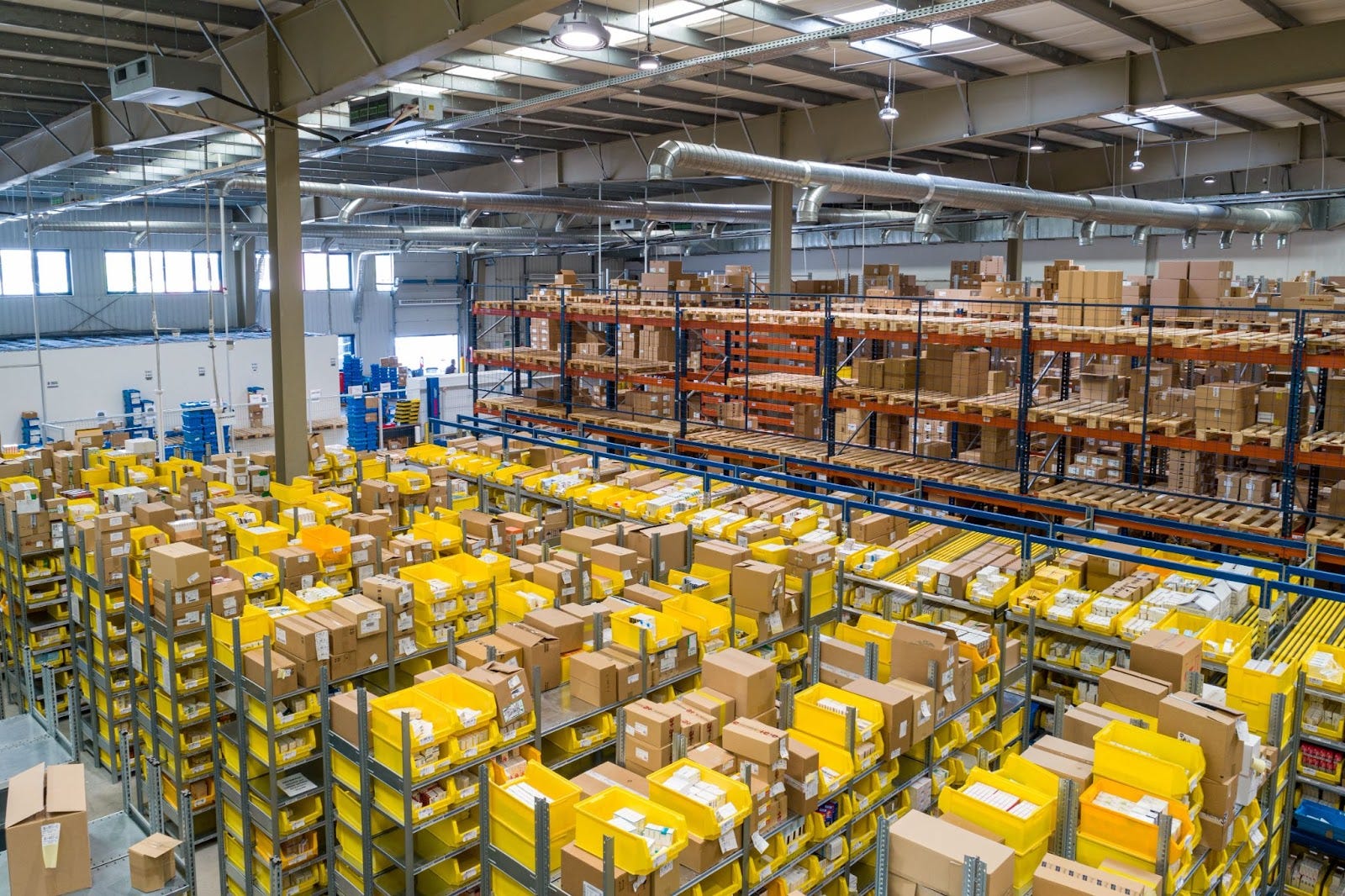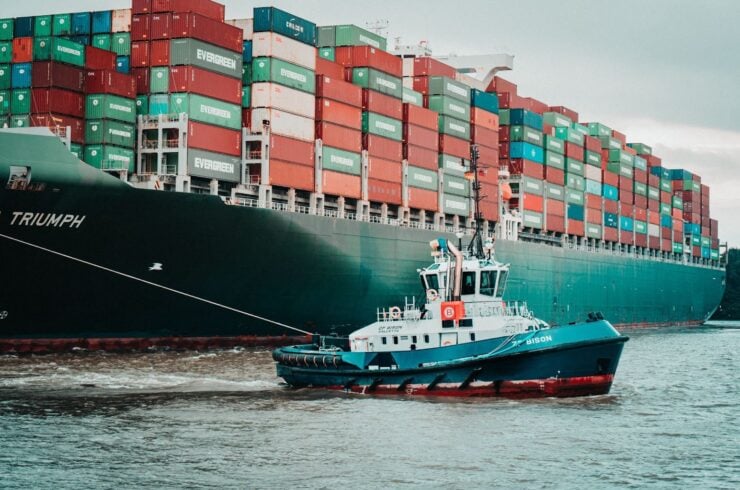In business, the term “supply chain” refers to the process of transforming raw materials into finished products and then getting those products to customers.
A supply chain is composed of all the businesses and individual contributors that play a role in this transformation, from suppliers and manufacturers to retailers and logistics providers.
An effective supply chain ensures that finished products are delivered to customers when they need them, in the right quantities. To achieve this, businesses need to carefully align their inventory levels, production schedules, and transportation networks.
There are some key things you should learn before trying to understand how to optimize your supply chain. In this article, we will:
- Introduce the concept of supply chain logistics
- Define the main components of a supply chain
- Discuss the importance of supply chain management
- Examine some of the biggest issues for supply chain managers
- Offer some tips on how to optimize your supply chain
- List a few common mistakes and explain how to avoid them
If you’re ready, let’s begin!
What are supply chain logistics?
Any business that manufactures or sells products needs to get those products from its factories or warehouses to its customers. The process of organizing this transportation and movement of goods is known as logistics.
Supply chain logistics, then, refers to the coordination and management of all the different businesses and moving parts involved in getting a product from supplier to customer. This includes managing suppliers, manufacturers, retailers, transportation providers, and any other businesses that contribute along the way.
It’s important to note that supply chain logistics is not the same as transportation management. Transportation management focuses on the movement of goods, while supply chain logistics encompasses the entire process from supplier to customer.
Example of supply chain logistics
Take a company that produces and sells bicycles. In their supply chain, they will need to manage the following businesses and processes:
- The suppliers who provide them with raw materials like steel, aluminum, and rubber
- The manufacturers who turn those raw materials into bike frames, wheels, and other parts
- The transportation companies that move the bikes from factories to warehouses and then to retail stores
- The retailers who sell the bicycles to customers
A well-organized supply chain ensures that each of these businesses is working efficiently and that finished products are delivered to customers on time.

What are the main components of a supply chain?
Let’s first go over that supply chain definition once again.
A supply chain is composed of all the businesses and individual contributors that play a role in transforming raw materials into finished products and then getting those products to customers.
There are four main components to any supply chain:
- Suppliers: businesses or individuals who provide raw materials, parts, or other inputs needed for production
- Producers: businesses that transform raw materials into finished products
- Distributors: businesses that move finished products from producers to retailers or other customer
- Retailers: businesses that sell finished products to consumers
At each stage of the supply chain, there is an opportunity to add value and improve efficiency. For example, a supplier might offer a discount for bulk orders, or a producer might use lean manufacturing techniques to reduce waste.
It’s also worth noting that most businesses play multiple roles in the supply chain. For example, a company might be both a producer and a distributor.
Or, a retailer might also operate its own warehouses and transportation fleet. Walmart, for instance, is traditionally a retailer but has made massive investments into distribution warehouses and transportation to help its transition into ecommerce.
A closer look is required here so that we can fully understand each component.
Suppliers
In the supply chain, suppliers provide businesses with the raw materials, parts, or other inputs needed for production. This might include things like metals, plastics, chemicals, and lumber.
Suppliers can be either upstream or downstream from a company in the supply chain. Upstream suppliers are those that provide inputs to a company’s production process, meaning they are further away from the finished product.
Downstream suppliers, on the other hand, provide inputs to a company that then sells or distributes those products to customers, meaning they are closer to the finished product.
There are three main types of supplier relationships:
- Direct relationships: where a company buys inputs directly from suppliers (this is most common for upstream suppliers)
- Indirect relationships: where a company buys inputs from another company that acts as a middleman (this is most common for downstream suppliers)
- Strategic relationships: where a company has a close, long-term relationship with one or more suppliers (this might involve joint planning and investment, and is common in industries where there are few suppliers)
Choosing the right supplier is an important part of supply chain management. A company needs to consider things like cost, quality, lead time, and capacity when selecting suppliers. It’s also important to build good relationships with suppliers, as this can lead to things like better prices and improved quality control.
Producers
Different than suppliers, producers represent the businesses that are in charge of transforming the raw materials into a finished product. In other words, they are the ones that take on the role of “manufacturing” or “assembly” within the supply chain.
While this may seem like the most critical role, it’s important to realize that the producer is only as good as the quality of the raw materials they receive.

Distributors
Once the product is manufactured, it needs to be delivered to the customer. This is where distributors come in. They are responsible for getting products from manufacturers to retailers or other customers.
There are two main types of distributors:
- Wholesalers: businesses that buy products from manufacturers and then sell them to retailers
- Third-party logistics providers (3PLs): businesses that provide warehousing, transportation, and other logistics services to producers and distributors
In some cases, manufacturers will sell directly to retailers, making producers and distributors the same. There are countless examples of that type of crossover, especially in large corporations that want to control every aspect of their supply chain, lowering risk and maximizing productivity.
Retailers
While some manufacturers will also want to sell directly to the customer, in most cases, it is the retailer who will take on this task. Retailers come in all shapes and sizes, from small mom-and-pop shops to large multinational corporations. They can sell products through brick-and-mortar stores, online marketplaces, or a combination of both.
The most important thing for retailers is to have a clear understanding of their target market.
- What are the needs and wants of their customer base?
- What types of products will they be interested in?
- How much are they willing to pay
- When and where do they want to make their purchase?
Answering these questions is essential for developing a successful marketing and sales strategy. It will also help retailers choose the right suppliers and distributors for their business.
What is supply chain management?
After understanding all of the different processes that go into a supply chain, management may seem like a daunting task.
Supply chain management is the art and science of coordinating these different moving parts to create a seamless flow that meets customer demands. In other words, it’s all about ensuring that the right materials are in the right place at the right time so they can be used to create finished products.
There are three main goals of supply chain management:
- To minimize cost
- To maximize customer satisfaction
- To optimize resources
Let’s take a closer look at why each of these goals is important.
Minimize cost
For any manager, minimizing costs is always a top priority. After all, the goal of any business is to generate revenue and profits. In the context of supply chain management, there are two main ways to reduce costs: by reducing the cost of materials and by reducing the cost of transportation.
Materials make up a large portion of the total cost of any product. Therefore, it’s important to source materials from suppliers who can offer competitive prices. Additionally, managers can save money by reducing waste and maximizing the use of raw materials.
Transportation overhead can also be significant, particularly if products need to be shipped long distances. To minimize these costs, managers can choose efficient transportation methods and work with logistics providers who offer competitive rates.

Maximize customer satisfaction
While it is sometimes easy to get caught up in the game of reducing costs, it’s important to remember that the ultimate goal is to satisfy customers.
If customers are not happy with the products they receive, they will take their business elsewhere. This can have a major impact on revenue and, ultimately, profitability.
That’s why it’s so important to focus on creating a supply chain that is customer-centric. This means designing processes and systems with the customer in mind so their needs are always met.
For example, customers may be more concerned with receiving their order quickly than with getting the lowest possible price. In other cases, they may be willing to pay a little extra for a product that is guaranteed to be high quality.
It’s up to supply chain managers to find the right balance between cost and customer satisfaction.
Optimize Resources
Sometimes, you don’t have endless resources to get the job done. Most of the time you have to make do with whatever you have on hand. That’s why it’s important to optimize the resources you do have.
This might mean using lower-cost materials, streamlining your production process, or finding new ways to reduce waste. It isn’t just about physical materials either, resource management refers to any limited company resource including time, money, staff, and storage space.
Capacity management, for example, is a key part of resource optimization. This involves ensuring that you have enough resources to meet customer demand without overproducing (and wasting valuable resources in the process).
Biggest supply chain issues for managers
In their attempt to minimize cost, maximize customer satisfaction, and optimize resource allocation, supply chain managers run into all kinds of problems:
- Long lead times
- Excess inventory
- Stockouts and backorders
- Capacity constraints
- Transportation disruptions
All of these issues can have a big impact on a company’s bottom line. To avoid them, supply chain managers need to be proactive and have a good understanding of both the big picture and the details of their operations.
How to streamline your supply chain
Good thing we’re here to help! Here are some tips on how to optimize your supply chain:
- Keep your network small: A large network of suppliers, manufacturers, and distributors can be difficult to manage. Try to work with a smaller number of trusted partners.
- Build strong relationships: Good communication and relationships with your supply chain partners are essential. Make sure you have a clear understanding of their capabilities and capacities.
- Be flexible: The ability to quickly adapt to changes in demand or the marketplace is crucial for supply chain success.
- Use technology: Technology can help you keep track of your inventory, production schedule, and transportation network. It can also help you communicate more effectively with your supply chain partners.
- Plan ahead: Anticipating problems and planning for contingencies will help you avoid disruptions in the supply chain.
- Be prepared to change: The best-laid plans often go awry. Be prepared to make changes on the fly and adjust your strategy as needed.
By following these tips you’ll already be well on your way to a strong supply chain but before you go, let’s take a look at some of the most common mistakes supply chain managers make, and how to avoid them.

Common mistakes to watch out for
Supply chain logistics is a huge field, and there will be specific problems that arise for everyone. But some general mistakes are made again and again. Here are a few of the most common, along with some tips on how to avoid them:
1. Not Defining Your Objectives
The first step in any supply chain optimization project should be to define your objectives. What exactly do you want to achieve? Do you want to reduce costs, improve delivery times, or both? Once you know what your goals are, you can develop a plan to achieve them.
2. Not Analyzing Your Data
Big data is one of the most important tools available to supply chain managers. But if you don’t know how to analyze it, it won’t do you any good. Make sure you have the right tools and personnel in place to make sense of your data and use it to improve your operations.
3. Not Communicating With Your Stakeholders
A successful supply chain optimization project requires buy-in from all stakeholders. That means keeping everyone informed of your plans and progress and getting their feedback along the way. If you’re not communicating with your team, you’re much less likely to achieve your goals.
4. Trying to Do Too Much at Once
Supply chain optimization is a complex process, and it’s important to take things one step at a time. Trying to accomplish too much all at once is a recipe for disaster. priorities and focus on one thing at a time, so you can make sure each change is implemented correctly.
5. Not Measuring Results
You can’t improve what you don’t measure. Make sure you establish metrics to track your progress and identify areas where you need to make changes. Without data, it will be very difficult to determine whether or not your efforts are paying off.
6. Not Planning for Disruptions
No matter how well you plan, there will always be disruptions to your supply chain. That’s why it’s important to have contingency plans in place to deal with them. By being prepared for the unexpected, you can minimize the impact of disruptions and keep your operations running smoothly.
7. Not Having a Backup Plan
A good supply chain optimization plan should always have a backup plan. Things will go wrong from time to time, and you need to be prepared for that. If you don’t have a fallback option, you risk losing everything you’ve worked so hard to achieve.
8. Not Learning From Your Mistakes
Mistakes are inevitable, but it’s important to learn from them. After each setback, take some time to analyze what went wrong and how you can prevent it from happening again in the future. By learning from your mistakes, you can make your supply chain more resilient and reduce the likelihood of future problems.
9. Giving Up Too Soon
Supply chain optimization is a long-term process, and it’s important to be patient. Results won’t happen overnight, and there will be setbacks along the way. But if you stick with it and keep working towards your goals, you will eventually see results.
10. Not Asking for Help
There’s no shame in admitting that you need help. If you’re having trouble getting started or making progress, reach out to a supply chain consultant or other experts who can help you get on the right track.
With these tips in mind, you can avoid some of the most common mistakes and set yourself up for success.
